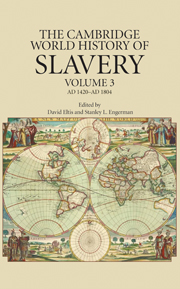Book contents
- Frontmatter
- Contents
- List of Maps, Figures, and Tables
- Contributors
- Series Editors' Introduction
- 1 Dependence, Servility, and Coerced Labor in Time and Space
- PART I SLAVERY IN AFRICA AND ASIA MINOR
- PART II SLAVERY IN ASIA
- PART III SLAVERY AMONG THE INDIGENOUS AMERICANS
- PART IV SLAVERY AND SERFDOM IN EASTERN EUROPE
- PART V SLAVERY IN THE AMERICAS
- PART VI CULTURAL AND DEMOGRAPHIC PATTERNS IN THE AMERICAS
- PART VII LEGAL STRUCTURES, ECONOMICS, AND THE MOVEMENT OF COERCED PEOPLES IN THE ATLANTIC WORLD
- 22 Involuntary Migration in the Early Modern World, 1500–1800
- 23 Slavery, Freedom, and the Law in the Atlantic World, 1420–1807
- 24 European Forced Labor in the Early Modern Era
- 25 Transatlantic Slavery and Economic Development in the Atlantic World: West Africa, 1450–1850
- PART VIII SLAVERY AND RESISTANCE
- Index
24 - European Forced Labor in the Early Modern Era
from PART VII - LEGAL STRUCTURES, ECONOMICS, AND THE MOVEMENT OF COERCED PEOPLES IN THE ATLANTIC WORLD
Published online by Cambridge University Press: 28 September 2011
- Frontmatter
- Contents
- List of Maps, Figures, and Tables
- Contributors
- Series Editors' Introduction
- 1 Dependence, Servility, and Coerced Labor in Time and Space
- PART I SLAVERY IN AFRICA AND ASIA MINOR
- PART II SLAVERY IN ASIA
- PART III SLAVERY AMONG THE INDIGENOUS AMERICANS
- PART IV SLAVERY AND SERFDOM IN EASTERN EUROPE
- PART V SLAVERY IN THE AMERICAS
- PART VI CULTURAL AND DEMOGRAPHIC PATTERNS IN THE AMERICAS
- PART VII LEGAL STRUCTURES, ECONOMICS, AND THE MOVEMENT OF COERCED PEOPLES IN THE ATLANTIC WORLD
- 22 Involuntary Migration in the Early Modern World, 1500–1800
- 23 Slavery, Freedom, and the Law in the Atlantic World, 1420–1807
- 24 European Forced Labor in the Early Modern Era
- 25 Transatlantic Slavery and Economic Development in the Atlantic World: West Africa, 1450–1850
- PART VIII SLAVERY AND RESISTANCE
- Index
Summary
This chapter will examine the general theme of forced labor performed by Europeans overseas during early modern times, that is, from 1500 to roughly 1800. First, a general overview will discuss who formed this labor pool and why. Second, a look at the possible totals of forced laborers will suggest the level of impact or social control forced labor represented in a given society. Third, an outline of how various European powers used forced labor during early modern times will reflect how multifaceted this subject was and where it overlapped with related themes, such as the military. Finally, I will turn to the specific case of the Portuguese as an in-depth example of this process. In doing so, I will underline similarities and contrast the differences between the Portuguese use of forced labor and how other early modern European powers used these same marginal figures in their societies. Because of large geographic and thematic gaps in the literature, this chapter is far from complete – even when we limit its scope to Europeans. In spite of this, I hope to provide a broad view of aspects of forced labor performed by them.
Marginal figures such as convicts, sinners, Gypsies, orphans, and prostitutes during early modern times became prime sources for various states to extract labor. At a minimum, these same figures could and did become forced colonizers. In Western societies, the legal basis and underlying model for forced labor is Roman.
- Type
- Chapter
- Information
- The Cambridge World History of Slavery , pp. 631 - 649Publisher: Cambridge University PressPrint publication year: 2011

